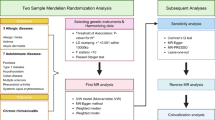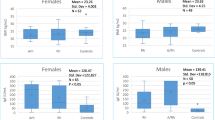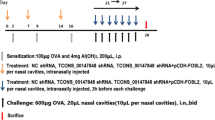Abstract
Forkhead-box J1 (FOXJ1) is a presumed transcription factor that can suppress T cell activity, at least partially, through the repression of NFκB activity. Thus, dysregulation of FOXJ1 is thought to be associated with autoimmune diseases and/or other inflammatory diseases. To investigate the association between single nucleotide polymorphisms (SNPs) of human FOXJ1 and allergic rhinitis, we scanned the whole human FOXJ1 gene, including the promoter region, by direct sequencing of DNA from 32 individuals. We identified seven SNPs, three of which (g.-460C>T, g.1805G>T, and g.3375G>C) were chosen for large sample size genotyping (n=713), and to assess the genotype frequencies of these SNPs between controls and allergic rhinitis patients. We also investigated the relationships of each genotype with serum total IgE levels in allergic rhinitis patients, and compared the frequencies of haplotypes constructed by these SNPs between the two groups. Our results suggest that the SNPs g.-460C>T, g.1805G>T and g.3375G>C in the human FOXJ1 gene might be associated with susceptibility to allergic rhinitis (P=0.0184, 0.0076, and 0.0143, respectively). The main haplotype, CGG, also revealed a significant association with allergic rhinitis (P=0.000018). However, no significant association was found between serum total IgE levels and the genotypes of these polymorphisms.
Similar content being viewed by others
Log in or create a free account to read this content
Gain free access to this article, as well as selected content from this journal and more on nature.com
or
References
Blatt EN, Yan XH, Wuerffel MK, Hamilos DL, Brody SL (1999) Forkhead transcription factor HFH-4 expression is temporally related to ciliogenesis. Am J Respir Cell Mol Biol 21:168–176
Brody SL, Yan XH, Wuerffel MK, Song SK, Shapiro SD (2000) Ciliogenesis and left–right axis defects in forkhead factor HFH-4-null mice. Am J Respir Cell Mol Biol 23:45–51
Carlsson P, Mahlapuu M (2002) Forkhead transcription factors: key players in development and metabolism. Dev Biol 250:1–23
Chae SC, Park YR, Lee YC, Lee JH, Chung HT (2004) The association of TIM-3 gene polymorphism with atopic disease in Korean population. Hum Immunol 65:1427–1431
Chae SC, Park YR, Oh GJ, Lee JH, Chung HT (2005a) The suggestive association of eotaxin-2 and eotaxin-3 gene polymorphisms in Korean population with allergic rhinitis. Immunogenetics 56:760–764
Chae SC, Park YR, Song JH, Shim SC, Yoon KS, Chung HT (2005b) The polymorphisms of Tim-1 promoter region are associated with rheumatoid arthritis in a Korean population. Immunogenetics 56:696–701
Chen J, Knowles HJ, Hebert JL, Hackett BP (1998) Mutation of the mouse hepatocyte nuclear factor/forkhead homologue 4 gene results in an absence of cilia and random left–right asymmetry. J Clin Invest 102:1077–1082
Cheng L, Enomoto T, Hirota T, Shimizu M, Takahashi N, Akahoshi M, Matsuda A, Dake Y, Doi S, Enomoto K, Yamasaki A, Fukuda S, Mao XQ, Hopkin JM, Tamari M, Shirakawa T (2004) Polymorphisms in ADAM33 are associated with allergic rhinitis due to Japanese cedar pollen. Clin Exp Allergy 34:1192–1201
Coffer PJ, Burgering BM (2004) Forkhead-box transcription factors and their role in the immune system. Nat Rev Immunol 4:889–899
Cookson W (2002) Genetics and genomics of asthma and allergic diseases. Immunol Rev 190:195–206
Daser A, Meissner N, Herz U, Renz H (1995) Role and modulation of T-cell cytokines in allergy. Curr Opin Immunol 7:762–770
Ho IC, Glimcher LH (2002) Transcription: tantalizing times for T cells. Cell 109:S109–S120
Kaestner KH, Knochel W, Martinez DE (2000) Unified nomenclature for the winged helix/forkhead transcription factors. Genes Dev 14:142–146
Lim L, Zhou H, Costa RH (1997) The winged helix transcription factor HFH-4 is expressed during choroid plexus epithelial development in the mouse embryo. Proc Natl Acad Sci USA 94:3094–3099
Lin L, Spoor MS, Gerth AJ, Brody SL, Peng SL (2004) Modulation of Th1 activation and inflammation by the NF-kappaB repressor Foxj1. Science 303:1017–1020
Lundback B (1998) Epidemiology of rhinitis and asthma. Clin Exp Allergy 28:3–10
O’Garra A (1998) Cytokines induce the development of functionally heterogeneous T helper cell subsets. Immunity 8:275–283
Okada A, Ohta Y, Brody SL, Watanabe H, Krust A, Chambon P, Iguchi T (2004) Role of foxj1 and estrogen receptor alpha in ciliated epithelial cell differentiation of the neonatal oviduct. J Mol Endocrinol 32:615–625
Passali D, Lauriello M, Mezzedimi C, Passali GC, Bellussi L (2001) Natural history of allergic rhinitis: a review. Clin Appl Immunol Rev 1:207–216
Sibbald B (1993) Epidemiology of allergic rhinitis. Monogr Allergy 31:61–79
Tran H, Brunet A, Griffith EC, Greenberg ME (2003) The many forks in FOXO’s road. Sci STKE 172: RE5
Wang M, Xing ZM, Lu C, Ma YX, Yu DL, Yan Z, Wang SW, Yu LS (2003) A common IL-13 Arg130Gln single nucleotide polymorphism among Chinese atopy patients with allergic rhinitis. Hum Genet 113:387–390
Weigel D, Jackle H (1990) The fork head domain: a novel DNA binding motif of eukaryotic transcription factors? Cell 63:455–456
Acknowledgement
This work was supported by a grant from the Korea Health 21 R&D Project by Ministry of Health & Welfare (01-PJ3-PG6-01GN09-003).
Author information
Authors and Affiliations
Corresponding author
Additional information
Chun-Shi Li and Soo-Cheon Chae contributed equally to this work.
Rights and permissions
About this article
Cite this article
Li, CS., Chae, SC., Lee, JH. et al. Identification of single nucleotide polymorphisms in FOXJ1 and their association with allergic rhinitis. J Hum Genet 51, 292–297 (2006). https://doi.org/10.1007/s10038-006-0359-8
Received:
Accepted:
Published:
Issue date:
DOI: https://doi.org/10.1007/s10038-006-0359-8



